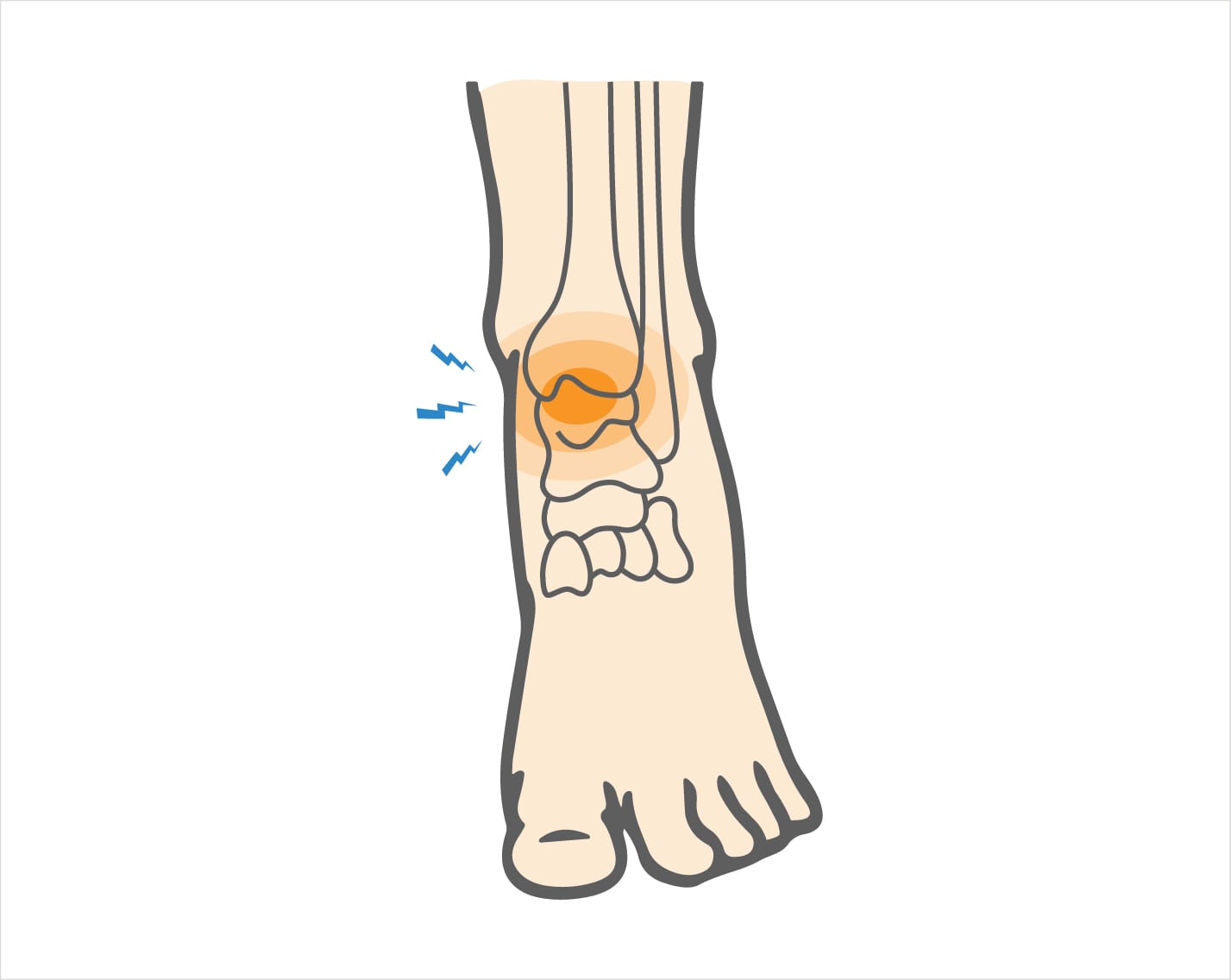An osteochondral injury is an injury to the articular surface or lining of the ankle joint. Cartilage on the outside of this joint, called the articular surface, provides the smooth gliding between the ankle joint and the underlying bone that supports it (the talus). Osteochondral damage can be caused by an acute impact injury, may be associated with a bad ankle sprain or fracture, or may occur as a result of chronic instability from a prior ankle injury that wears away the cartilage surface. Osteochondral injuries can range in severity. Early cartilage damage may be associated with softening of the cartilage that progresses to tears and unstable flaps. If the underlying bone is compromised, chunks of cartilage along with the underlying bone may be displaced, leaving a hole in the articular surface. This may cause pain. Displaced fragments can cause “locking” and affect the ankle joint’s range of motion.
Osteochondral Injury of the Ankle Joint Symptoms & Treatment
An osteochondral injury is an injury to the articular surface or lining of the ankle joint. Cartilage on the outside of this joint, called the articular surface, provides the smooth gliding between the ankle joint and the underlying bone that supports it (the talus). Osteochondral damage can be caused by an acute impact injury, may be associated with a bad ankle sprain or fracture, or may occur as a result of chronic instability from a prior ankle injury that wears away the cartilage surface.
Overview
Overview

What causes Osteochondral Injury of the Ankle Joint?
Osteochondral injuries usually are caused by a twisting motion that results in an ankle sprain. During this type of injury, the talus bone or surrounding cartilage may come into contact with the shin bones (the tibia and fibula), bruising or fracturing the smooth articular surface.
Osteochondral injuries are most common in these sports:
• Soccer
• Football
• Rugby
• Basketball
Symptoms
Initial osteochondral injury may feel like an ankle sprain, occurring as a dull ache that hurts more when weight is placed on the ankle. Symptoms will depend on the severity of the injury.
Common symptoms may include:
• Pain
• Persistent swelling
• Limited range of motion
• Difficulty walking
• Intermittent “locking” of the ankle joint
When to see a doctor
If after an ankle injury, your ankle remains swollen and painful to walk on, you should consult with your doctor. During your visit, your doctor will ask questions about your injury, its symptoms, and the sports you play. During the physical examination, your doctor will press your ankle to see if your ligaments are damaged. A weight-bearing x-ray may also be ordered to see if thinning of the cartilage surface, or “joint space,” has occurred. X-rays may also show “pothole” defects in the bone at the ankle joint. MRIs are useful for showing cartilage lesions and underlying bone damage and bone swelling, or edema.
Non-operative treatment
Minor osteochondral injuries are treated non-surgically. Initial treatment will include avoiding activities that cause pain in the ankle. Other non-surgical treatment measures include:
• Ice for 20 minutes every two to three hours
• Elevating the ankle
• Compression with an Ace bandage for swelling
• Nonsteroidal anti-inflammatory drugs (NSAIDs), such as ibuprofen and naproxen, to relieve pain
• Wearing a special ankle brace or cast to support your ankle and protect it from re-injury
• Physical therapy and a gradual return to weight-bearing activity
Try these exercises to help address your condition:
Below is a PDF of the Exercise Program
Surgical Treatment
For severe injuries, your doctor may refer you to an orthopedic surgeon. Surgery may be needed to remove fragments of cartilage or bone (called debridement), drill holes into the joint to promote new growth where cartilage has been damaged, or transplant new bone and cartilage tissue. Your surgeon will discuss the most appropriate treatment for you.
Recovery
Recovery from an osteochondral injury of the ankle joint will depend on the extent of the injury and type of treatment, and can range from several weeks to many months. The rehabilitation period will include a gradual return to weight-bearing activity and physical therapy.
GET BACK TO WHAT YOU LOVE. FASTER
Sources
http://www.aofas.org/footcaremd/conditions/ailments-of-the-ankle/Pages/Osteochondral-Lesion.aspx
https://www.drpribut.com/sports/sp-ocd.html
https://www.uwhealth.org/sports-medicine/clinic/osteochondral-injuries/10110
https://viewmedica.com/vm/index/brochure/68/osteotalus/en
http://www.advancedfootanklewi.com/PainTreatmentMilwaukee/Injuries
https://orthoinfo.aaos.org/en/diseases–conditions/sprained-ankle/

